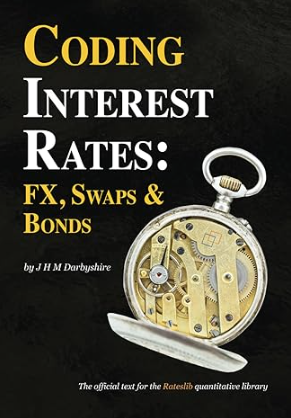About#
Release Notes#
The History and Context of Rateslib#
Rateslib BETA was first released in April 2023.
The foundations of rateslib is really the code library Book IRDS3, which laid down basic principles and was a sandbox code environment for the publication Pricing and Trading Interest Rate Derivatives: A Practical Guide to Swaps. Some of the code and algorithms also date back to the author’s time trading IRSs as a market-maker between 2006 and 2017. The algorithms and mathematical code developments of rateslib are all characterised and explained in Coding Interest Rates: FX, Swaps and Bonds.
Five Pillars of Rateslib’s Design Philosophy#
1) Maximise flexibility : Minimise user input#
This is a user interface (UI) objective. Rateslib aims to make technical and complex financial instrument analysis easily accessible and consumable. This philosophy has shaped the the entire design and API architecture of rateslib.
For example, this library will not add esoteric or complex algorithms for valuing a financial instrument. Although doing so satisfies the philosophy of maximising flexibility, every addition adds documentation obfuscation, uncertainty about market practice and likely extends parameter numbers. It breaks the philosophy.
On the other hand this library will allow various Curve construction interpolation algorithms because these are market standard and their parametrisation is simple and well documented, and these have considerable impact on all users. It satisfies the philosophy.
2) Prioritise sensitivities above valuation#
This is a functionality objective. Risk sensitivities are harder to calculate than valuation. To calculate risk it is necessary to be able to calculate value. To calculate value it is not necessary to calculate risk. Therefore making design choices around calculating risk avoids the problem of building Instruments in a value sense and ‘hacking’ risk sensitivities later.
This philosophy indirectly drives performant solutions. It is also the reason that the library constructed and implemented its own automatic differentiation (AD) toolset to properly label and be able to pass around derivatives from any object or scenario to another. It also means that npv, delta and gamma have the same arguments signature, which promotes usability.
3) Unify asset classes within a single UI#
This defines scope. Rateslib aims to unify interest rates, FX and inflation in its first version. The ambition is to incorporate volatility products into version two. Within this unification we must include the commonly traded instruments within each of these classes.
4) Achieve scalable performance#
This is a functionality objective. Version one of rateslib is pure Python. The performance constraints this places are restrictive. However, every method rateslib offers must be capable of producing results in practical time. A fixed income library written in Python cannot achieve what rateslib achieves without AD. Additionally many manual optimisations are implemented and are documented.
A wider article about performance in rateslib is available following the link.
5) Be transparent and validate as default#
This is a community objective. No algorithm, optimisation or approximation is added without being documented in Coding Interest Rates. The code coverage of the library strives to be 100%. This API documentation should be exhaustive with demonstrative examples. Where official sources (ISDA documentation, academic papers, issuer specifications) are available their examples should be used as unit tests within rateslib.
A good example for these are the UK DMO’s Gilt calculations which are replicated exactly by rateslib. Another example is the replication of Norges Bank NOWA calculator

